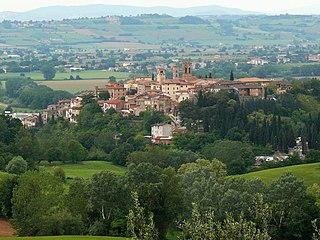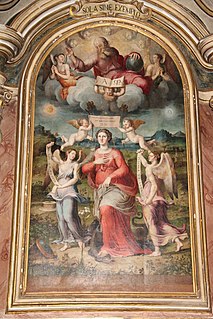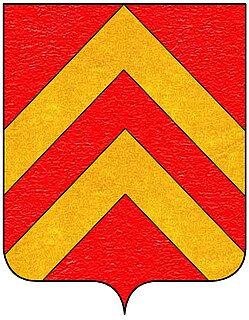
The Salt War of 1540 was a result of an insurrection by the city of Perugia against the Papal States during the pontificate of Pope Paul III. The principal result was the city of Perugia's definitive subordination to papal control.

The Salt War of 1540 was a result of an insurrection by the city of Perugia against the Papal States during the pontificate of Pope Paul III. The principal result was the city of Perugia's definitive subordination to papal control.
Perugia had been a free commune until 1370, when it was de jure incorporated into the Papal States. The Perugian elite continued to enjoy a sort of semi-autonomy, including several privileges like trial by a local (not papal-appointed) judge and freedom from paying any taxes on salt, then an important product for preserving food. Beginning in the late 15th century, successive popes attempted to rein in Perugian autonomy, despite resistance by the Perugians. This came to a head after a disastrous harvest in 1539, which drove up prices in Perugia and its rural hinterland. [1]
In this already economically difficult situation, Pope Paul III decided to levy a new tax on salt for all his subjects. This violated treaties between Perugia and previous popes, treaties which Paul III had confirmed at the beginning of his pontificate, but Perugian protests were to no avail. The Perugians decided to rebel but on 4 June 1540 papal troops, led by the pope's son Pierluigi Farnese and his condottiere Alessandro da Terni, forced a surrender.
Shortly thereafter, an enormous fortress, the Rocca Paolina (Pauline Fortress), was constructed on the plans designed by Antonio and Aristotele da Sangallo. Built not to protect Perugia but, in Julius III's words, "to slow down the burning of the Perugians and get rid of the opportunity to rebel against the Holy See," the fort was for centuries a symbol of oppressive papal rule. [2] Despite the fact that a later Pope, Julius III, gave the Perugians back a semblance of local rule in 1559, [3] the city became part of the Papal States and remained so until Italian unification in 1860.
One curious note about the war is that Perugian legend holds that as part of a popular protest against the new papal tax in 1540, citizens stopped putting salt in their bread (unsalted bread is the norm to this day). Recent research suggests that this is an urban legend developed after 1860. [4]

Pope Honorius IV, born Giacomo Savelli, was head of the Catholic Church and ruler of the Papal States from 2 April 1285 to his death in 1287. During his pontificate he largely continued to pursue the pro-French political policy of his predecessor, Martin IV.

Umbria is a region of central Italy. It includes Lake Trasimeno and Marmore Falls, and is crossed by the River Tiber. It is the only landlocked region on the Apennine Peninsula. The regional capital is Perugia.

Perugia is the capital city of Umbria in central Italy, crossed by the River Tiber, and of the province of Perugia. The city is located about 164 km (102 mi) north of Rome and 148 km (92 mi) southeast of Florence. It covers a high hilltop and part of the valleys around the area. The region of Umbria is bordered by Tuscany, Lazio, and Marche.

Città di Castello ; "Castle Town") is a city and comune in the province of Perugia, in the northern part of Umbria. It is situated on a slope of the Apennines, on the flood plain along the upper part of the river Tiber. The city is 56 km (35 mi) north of Perugia and 104 km (65 mi) south of Cesena on the motorway SS 3 bis. It is connected by the SS 73 with Arezzo and the A1 highway, situated 38 km (23 mi) west. The comune of Città di Castello has an exclave named Monte Ruperto within Marche.

Braccio da Montone, born Andrea Fortebraccio, was an Italian condottiero.

Deruta is a hill town and comune in the Province of Perugia in the Umbria region of central Italy. Long known as a center of refined maiolica manufacture, Deruta remains known for its ceramics, which are exported worldwide.

Cospaia is an Italian hamlet (frazione) of the comune of San Giustino in the Province of Perugia, Umbria.

Raffaellino del Colle (1490–1566) was an Italian Mannerist painter active mostly in Umbria. He was born in the frazione of Colle in Borgo Sansepolcro, province of Arezzo, Tuscany, Italy.

The Duchy of Sora was a semi-independent state in Italy, created in 1443 by King Alfonso I of Naples and dissolved in 1796. It occupied the south-eastern part of what is today Lazio, bordering what is now Abruzzo. Its capital was first Sora, and later, under the Boncompagni family, Isola di Sora.

The Roman Catholic Diocese of Città di Castello is a Latin suffragan bishopric in the ecclesiastical province of the metropolitan Archdiocese of Perugia-Città della Pieve, in the central Italian region of Umbria.

The Republic of Cospaia was a small state within modern-day Italy, located in northern Umbria, independent from 1440 to 1826. It was located in what is now the hamlet (frazione) of Cospaia in the comune of San Giustino in the Province of Perugia.

Perugia was a long-time papal residence during the 13th century. Five popes were elected here: Pope Honorius III (1216–1227), Pope Clement IV (1265–1268), Pope Honorius IV (1285–1287), Pope Celestine V (1294), and Pope Clement V (1305–1314). These elections took place in the Palazzo delle Canoniche adjoining the Perugia Cathedral.

Fulvio Giulio della Corgna was a Tuscan Catholic bishop and cardinal.

Castello di Reschio forms part of a chain of walled settlements in proximity of the Tuscan boundaries. It belonged to the county of Porta Sant’Angelo of the commune of Perugia, perched on a hillock above the valley of Pierle, along the right riverbank of the Niccone stream. Today it is part of the communal territory of Lisciano Niccone, province of Perugia.
The War of L'Aquila was a conflict in 15th-century Italy. It started in 1423 as a personal conflict against the condottiero Braccio da Montone and the city of L'Aquila in Abruzzo, but later turned into a national conflict when the forces of the Duchy of Milan, the Republic of Florence, the Papal States, and the Kingdom of Naples were also involved. Braccio da Montone was killed in the final battle near L'Aquila.
The following is a timeline of the history of the city of Perugia in the Umbria region of Italy.
The La Compagnia della Stella was the name of two separate companies of mercenary soldiers which operated in northern Italy at different times in the 14th century.

The County of Montone was a noble fiefdom in Italy, formed of the town of Montone and its territory. That territory was turned into a county by Antipope John XXIII on 28 August 1414 and granted by him to Braccio da Montone, a condottiero. Pope Martin V refounded it and on Braccio's death in 1424 confirmed it to Braccio's son Carlo. It was under the jurisdiction of the Papal States until 1519, when pope Leo X granted it to Vitello Vitelli, a member of the Vitelli family of Città di Castello. That family held it until 1573 and then from 1598 to 1646, when their line went extinct.
The Rocca Paolina was a Renaissance fortress in Perugia, built in 1540-1543 for Pope Paul III to designs by Antonio da Sangallo the Younger. It destroyed a large number of Etruscan, Roman and medieval buildings, including the Baglioni family's houses in the burgh of Santa Giuliana as well as over a hundred tower-houses, gates, churches and monasteries. It turned the former streets of the historic city centre into underground passageways, which are now open to the public.

The House of the Bourbon di Sorbello marquises is a noble family originating in the early Middle Ages, the holder until 1819 of the imperial fief of Sorbello, entering among the ranks of the oligarchy of the city of Perugia in the 18th century.